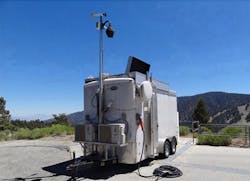Trailer-sized AMOLITE lidar station reads atmosphere to 10 km altitudes
Researchers from the Air Quality Processes Research Section, Environment and Climate Change Canada (ECCC; Toronto, Canada), have developed the Autonomous Mobile Ozone Lidar Instrument for Tropospheric Experiments (AMOLITE) to obtain atmospheric profiles from near to the ground to altitudes of more than 10 km.
RELATED ARTICLE: Application parameters dictate laser source selection in lidar systems
Lidar (light detection and ranging) technology has rapidly advanced over the past several decades. From a number of different platforms, this technique can now be used to measure a variety of atmospheric constituents with ever increasing accuracy and at ever finer scales, but typically require an operator to control the complex equipment. To overcome the need for a lidar operator, a team at Environment and Climate Change Canada (ECCC) has previously designed several autonomous aerosol lidar systems to support a number of research objectives.
The AMOLITE system builds upon the successes of their earlier autonomous lidars, but now uses a synergistic approach to simultaneously measure the vertical profiles of tropospheric ozone, aerosols, and water vapor. The design combines a dual laser for redundancy purposes and a dual lidar design; that is, the tropospheric ozone Differential Absorption lidar (DIAL) and an aerosol lidar with three backscatter channels, two Raman channels, and one cross-polarization channel (‘3+2+1’ configuration). In addition, a water vapor channel--arising from the Raman-shifted 355 nm output (407 nm)--has been added to provide nighttime water vapor profiles. The final product of the system is lidar profiles (near-ground to 10-15km altitude) at minute-long intervals. The system is operated remotely 24 hours a day, seven days a week (except during precipitation events). Furthermore, data is updated hourly to a website, thus enabling near-real-time analysis.
The team was able to evaluate the performance of its AMOLITE ozone lidar through an intercomparison study--with four other tropospheric ozone lidar systems, all of which are part of the Tropospheric Ozone Lidar Network(TOLNet). They conducted this study--known as the Southern California Ozone Observation Project (SCOOP)--at the Jet Propulsion Laboratory's Table Mountain Facility in Wrightwood, CA. The results show a good level of agreement between AMOLITE and other lidar systems.
SOURCE: SPIE Newsroom; http://spie.org/newsroom/6870-autonomous-ozone-aerosol-and-water-vapor-profiling-of-the-atmosphere
About the Author

Gail Overton
Senior Editor (2004-2020)
Gail has more than 30 years of engineering, marketing, product management, and editorial experience in the photonics and optical communications industry. Before joining the staff at Laser Focus World in 2004, she held many product management and product marketing roles in the fiber-optics industry, most notably at Hughes (El Segundo, CA), GTE Labs (Waltham, MA), Corning (Corning, NY), Photon Kinetics (Beaverton, OR), and Newport Corporation (Irvine, CA). During her marketing career, Gail published articles in WDM Solutions and Sensors magazine and traveled internationally to conduct product and sales training. Gail received her BS degree in physics, with an emphasis in optics, from San Diego State University in San Diego, CA in May 1986.
